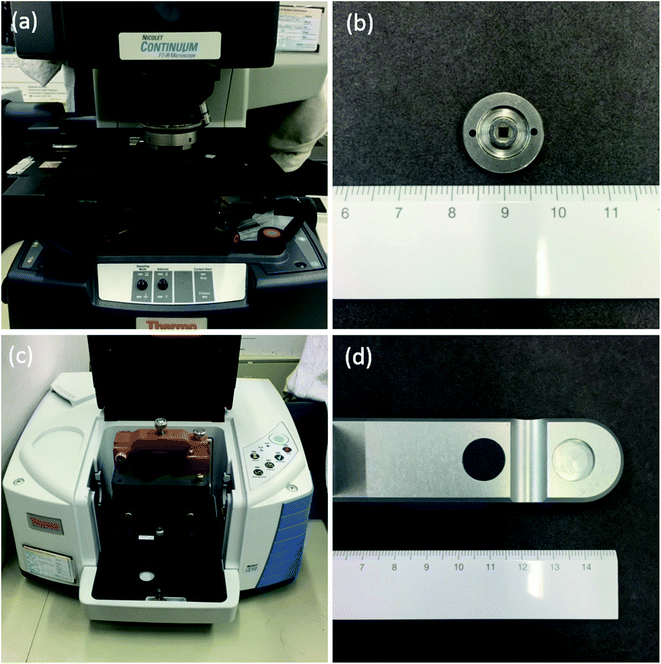Identification of plastics in cultural heritage collections by Fourier transform infrared spectroscopy (FTIR)
Analytical Methods Committee, AMCTB No. 83
First published on 1st February 2018
Abstract
Infrared spectroscopy is the most commonly used analytical technique for identifying polymeric compounds, such as cellulose acetate, cellulose nitrate, polyurethane, Perspex, PVC and nylon in analytical laboratories. Other relevant techniques for identification include Raman spectroscopy (see Analytical Methods Committee, AMCTB No. 67) and pyrolysis gas chromatography mass spectrometry (Py-GCMS). This technical brief focuses on the application of FTIR spectroscopy and outlines the different types of materials commonly found in museum collections. The different types of attachments and techniques, which have been developed to address the various forms of materials and minimise the need for sampling, are also described here.
Introduction
Objects made from plastic are now increasingly common in heritage collections with objects dating from the early 20th century onwards. One of the complications associated with plastics in collections is that objects often contain many different types of plastics with varying chemical compositions. It is this differing composition of heritage objects that is responsible for the chemical degradation pathways of the plastics, for example, some degrade primarily by oxidation, others by hydrolysis, etc. In order to select a potential preservation strategy, conservation treatment or to mitigate against further chemical degradation (e.g. by controlling selected environmental parameters), the chemical composition must be known.Depending on the nature of the collection and age of the objects, the composition of heritage objects may range from the older semi-synthetic plastics to completely synthetic materials. Semi-synthetic materials, as the name implies, are made by chemically modifying natural materials such as cellulose or milk proteins. Examples include cellulose nitrate, cellulose acetate and casein, materials which were initially made to imitate more expensive natural materials like amber, tortoiseshell, ivory, etc., as the natural materials became rare and expensive.
Sampling
When analysing heritage objects, non-invasive techniques are preferred where available and applicable. Samples, when they are taken, are extremely small, usually less than one millimeter across. In order to produce useful spectra it is necessary to choose the most appropriate means for interaction of the sample with the infrared (IR) radiation. In transmission methods the beam passes through the sample. In reflectance methods the changes in the IR beam as it is reflected by the sample is measured.Equipment, attachments and techniques
Although bench-top FTIR spectrometers have been in use for decades, portable and trans(portable) instruments have also been developed in the last few years. The ability to identify the material of an object in situ is very useful for the management of collections.Contemporary FTIR couples a microscope to the spectrometer for the analysis of minute samples (Fig. 1a). This method is particularly relevant for the analysis of objects where sampling is an issue, as the sample required is extremely small (usually a fraction of a millimeter). The introduction of the diamond anvil cell in the 1960s allowed solid samples to be analyzed via transmission methods. This is achieved by the production of a very thin film of the solid by clamping it between two diamond surfaces under pressure. The minute sample is placed on the window of the diamond cell (Fig. 1b) and examined under the microscope.
 | ||
| Fig. 1 (a) Example of FTIR microscope, (b) a diamond cell, (c) an ATR Golden Gate attachment and (d) dark silicon carbide paper disc. All images © Victoria and Albert Museum. | ||
Reflectance techniques such as attenuated total reflectance (ATR) enable materials to be examined directly in the solid. ATR attachments such as the Golden Gate (Fig. 1c) are used in conjunction with bench-top spectrometers and are very useful for samples of materials such as rubbers, foams and fibres. However, they do require a small sample to be taken. Modern moulded plastic objects often have seams or injection points with excess material where sampling can be done almost invisibly.
More recent ATR attachments work well with plastics and, depending on the size of the object, do not require the removal of a sample. If the object is of a suitable size, the ATR accessory is put in contact with the surface and the pressure carefully increased until an acceptable spectrum is obtained. If the analysed surface is soft, a small impression may be left behind.
Diffuse Reflectance Infrared Fourier Transform Spectroscopy (DRIFTS) is a technique used in conjunction with a bench-top system in which the IR beam is diffusely reflected from the surface of a sample (Fig. 1d). The minute amount of sample required for this technique is collected by rubbing the object gently with a disc of silicon carbide paper. This method is particularly useful for obtaining samples of thin surface coatings.
Spectral quality
Bands in reflectance spectra are generally weaker and their position shifted in comparison to those obtained in transmission. The two common methods of reflectance measurements, ATR and DRIFTS, are frequently used because taking samples from museum objects is often contentious.Pure synthetic polymers produce spectra with sharp vibrational bands which are readily identifiable. Semi-synthetic and naturally occurring polymers often give rise to FTIR spectra whose bands are generally broader than those found in completely synthetic polymers. This may be due to the presence of both crystalline and amorphous regions in the materials. In any sample where hydrogen bonding occurs, the number and strength of intermolecular interactions varies greatly within the sample, causing the spectral bands to be particularly broad. The infrared spectrum of a complex mixture also gives so many absorption bands that these often overlap to the point of yielding only broad envelopes of absorption with few distinctive features.
Spectral interpretation
FTIR produces a characteristic spectrum for any compound which is dependent on the functional groups that are present. In theory, the presence of these known functional groups allows the interpretation of the spectra and the identification of the sample. In practice, the resulting spectra are searched against either commercial library databases or databases produced by shared initiatives such as the IRUG (Infrared and Raman Users Group) whose spectra come from heritage organisations. These spectra are from standards that are more compatible with samples found in heritage laboratories, e.g. they may be aged materials, just like the ones that would be obtained from a real, old object, as opposed to spectra from newly made materials in commercial libraries.Further reading
1 Infrared & Raman Users Group http://www.irug.org/.2 http://popart-highlights.mnhn.fr/index.html.
3 Y. Shashoua, Conservation of Plastics, Routledge, 2012, ISBN 1136415165.
4 G. Mitchell, F. France, A. Nordon, P. L. Tang and L. T. Gibson, Assessment of historical polymers using attenuated total reflectance-Fourier transform infra-red spectroscopy with principal component analysis, Heritage Sci., 2013, 1, 28.
5 J. Coates, Interpretation of infrared spectra – a practical approach, in Encyclopaedia of analytical chemistry, ed. R. A. Meyers, John Wiley & Sons Ltd, Chichester, 2000.
![[thin space (1/6-em)]](https://www.rsc.org/images/entities/char_2009.gif)
Dr Brenda Keneghan, Victoria and Albert Museum, London.
![[thin space (1/6-em)]](https://www.rsc.org/images/entities/char_2009.gif)
This Technical Brief was prepared by the Heritage Science Subcommittee and approved by the Analytical Methods Committee on 17/01/2018.
| This journal is © The Royal Society of Chemistry 2018 |


